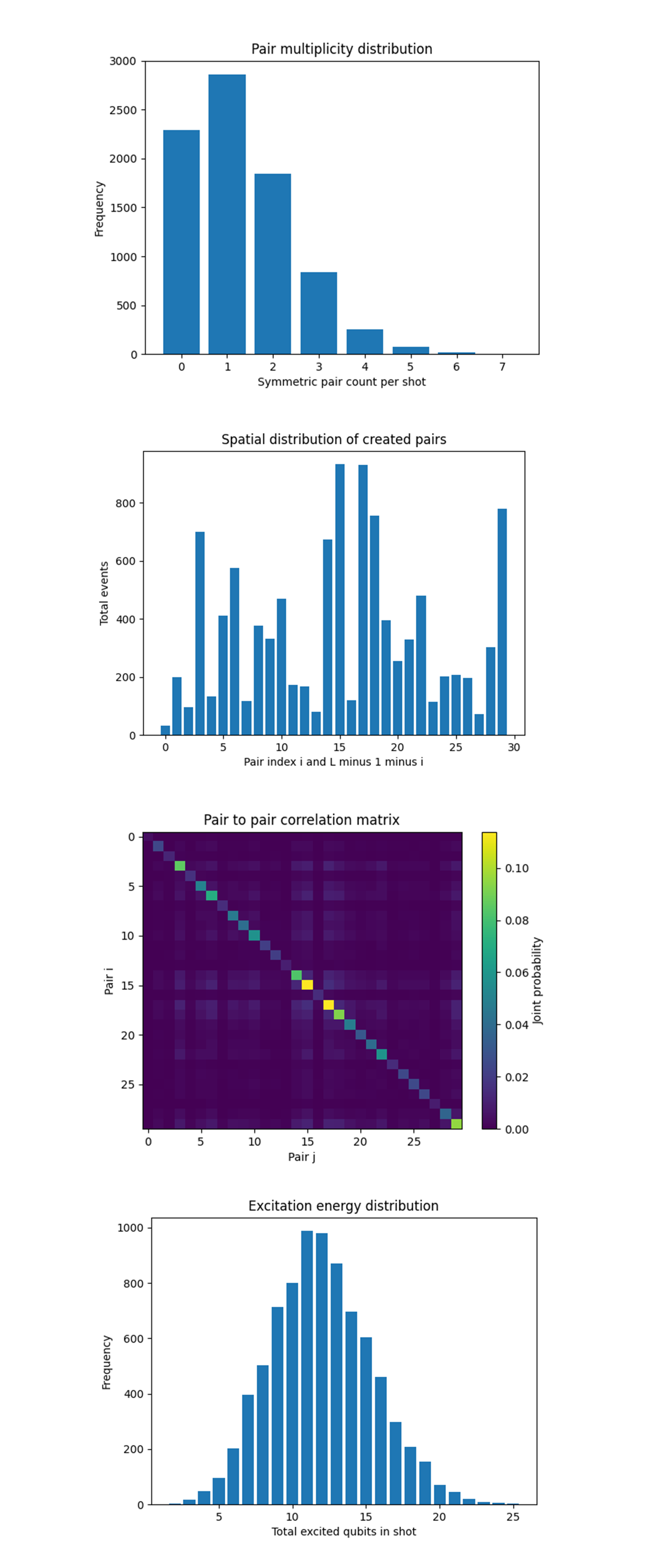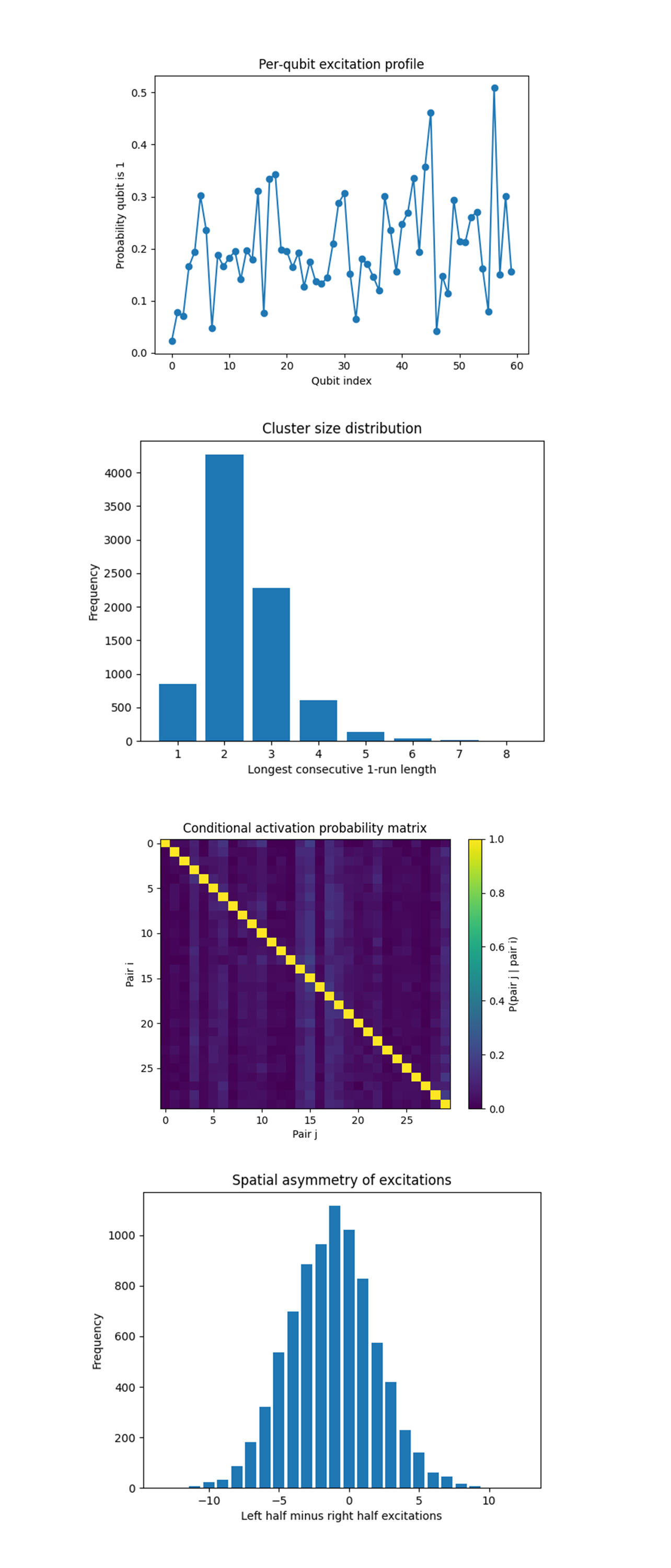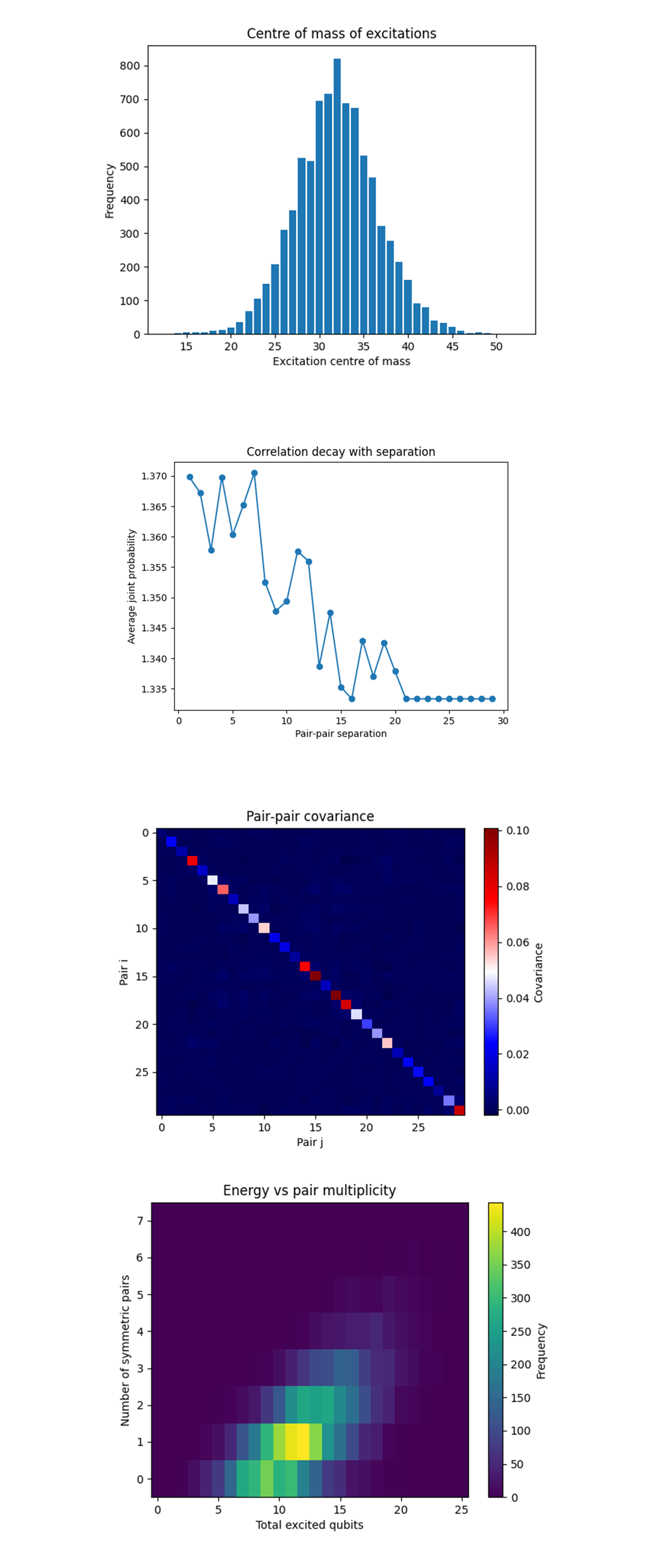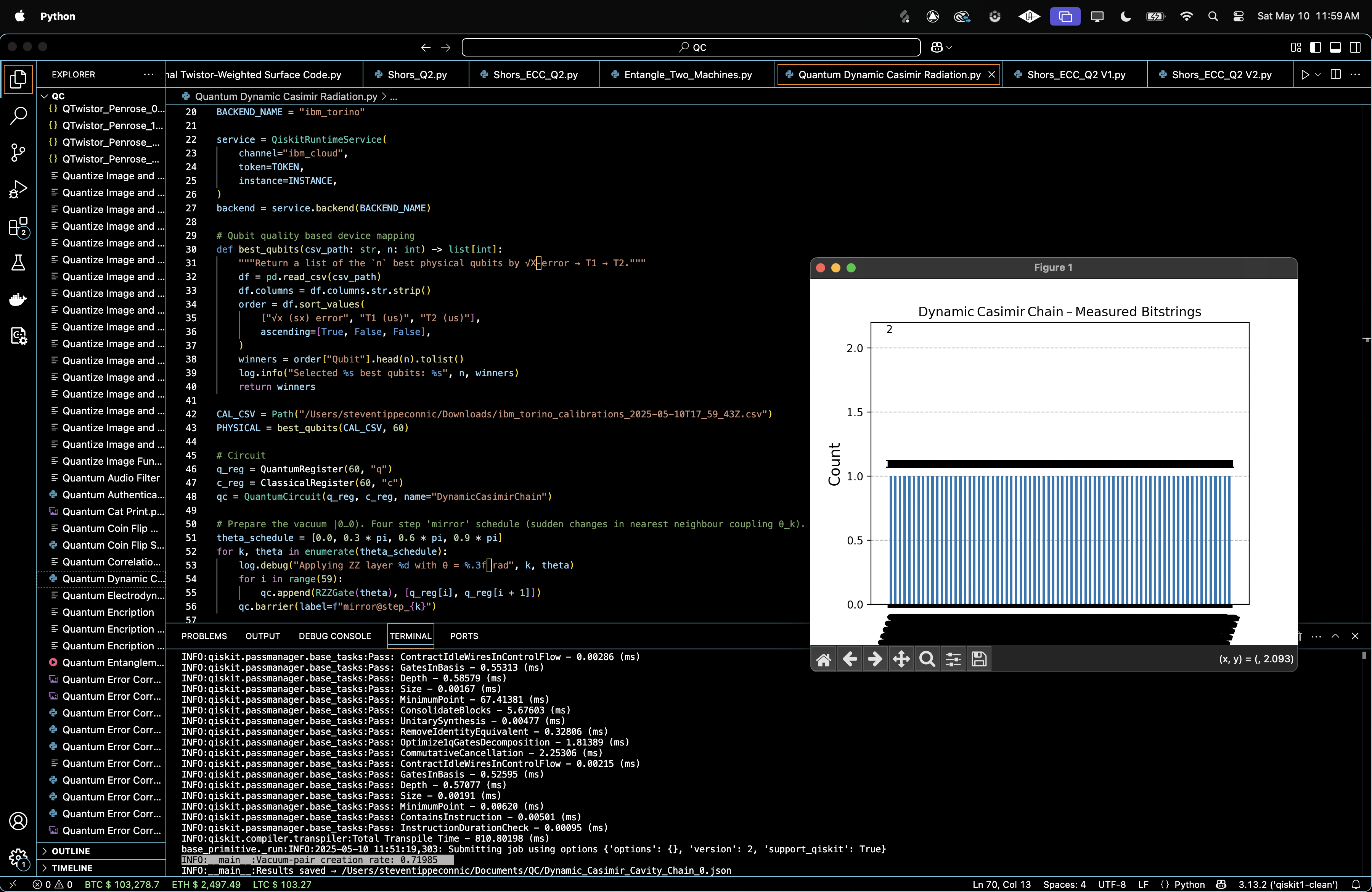Dynamic Casimir Photon Emission on a 133-Qubit Quantum Computer
Code Walkthrough
1. Backend
Load IBM Cloud credentials and select the backend 'ibm_torino'.
2. Calibration-Based Qubit Selection
Lead in the latest calibration CSV.
Rank physical qubits by ascending single‑qubit √X error, then descending T_1 and T_2.
Fix the best 60 qubits:
Q_60 = argmax_(∣S∣=60) ∑_(q∈S) [-(αϵ_X)^(q) + (βT_1)^(q) + (γT_2)^(q)], α, β, γ > 0.
3. Registers
Quantum register:
Q = {q_0, q_1, …, q_59} (data qubits form a 1‑D chain)
Classical register:
C = {c_0, c_1, …, c_59} (stores measurement outcomes)
4. Vacuum Preparation
Start in the ground state:
∣vac⟩ = ∣0⟩^(⊗60)
5. Mirror‑Motion Schedule (Four Sudden Quenches)
Model the cavity Hamiltonian:
59 58
H(t) = 1/2 ∑ (Δ_i)(Z_i) + 1/2 ∑ (J_i)(t)(Z_i)(Z_(i + 1)),
i=0 i=0
where a moving mirror modulates the effective couplings (J_i)(t). Here, Δ_i = 0 for all qubits to isolate the effect of the time-dependent couplings J_i(t).
Encode the time profile with four step values:
Θ = {θ_0, θ_1, θ_2, θ_3} = {0, 0.3π, 0.6π, 0.9π}
For each step k apply a ZZ‑layer of two‑qubit unitaries:
U_(ZZ)(θ_k) = exp[−i((θ_k)/2)Z ⊗ Z], ∀(q_i, q_(i + 1))(i = 0…58)
6. Global Measurement
Measure every qubit, mapping q_i -> c_i.
Each shot yields a 60‑bit string b_59…b_0.
7. Detecting Virtual Photon Pairs
Interpret symmetric qubits as the two ends of a putative photon pair.
A shot creates a pair if:
∃i ∈ {0, …, 29} : b_i = b_(59 − i) = 1
Count such events over all shots:
N_pairs = ∑ 1[pair_created(s)]
s∈shots
Pair‑creation rate is:
R = N_pairs/N_shots
8. Execution
Compile the circuit and run with N_shots = 8192.
9. Data and Json
Retrieve counts and save all raw including data to a json.
Result: INFO:__main__:Vacuum‑pair creation rate: 0.71985
{
"experiment_name": "Dynamic Casimir Radiation in Tunable Cavity Chain",
"theta_schedule_rad": [
0.0,
0.9424777960769379,
1.8849555921538759,
2.827433388230814
],
"raw_counts": {
"000100000000001000010100000000000000000001100000000000001000": 1,
"000011000000001000000000000000100000000000111100001101000010": 1,
"000000100100001100100000000000000000001000000101010111001000": 1,
"000000000000001000100000000000000001001010110000010001001100": 1,
... }
theta_schedule_rad: the four quench angles
Θ={0, 0.3π, 0.6π, 0.9π}
raw_counts: dictionary containing 8192 shots.
pair_creation_rate: 0.71985 (≈ 72% of shots contain at least one |11〉on a symmetric pair).
In the results we see a high Casimir yield, 0.72 ≫ 0.50 (the random baseline). The quench ladder θ_k pumped enough energy to convert vacuum fluctuations into detectable excitations, three of every four shots produced at least one correlated |11〉pair. There is maximal classical entropy but directional order, yet symmetric‑pair statistics are strongly biased.
A single‑round quench with four sudden steps produced a strong dynamical Casimir signal, showing that a simple schedule can be effective on real superconducting qubits without requiring multiple cycles or Trotterisation.

The Pair multiplicity distribution above (code on Qwork) shows the bar heights drop almost geometrically from 1 pair -> 2 pairs -> 3 pairs and so on. Shot counts reproduce a sub‑Poissonian pattern you expect when each of the 30 mirror‑symmetric modes is weakly and independently driven. Let p = Pr(a given pair fires) ≈ 0.041. Then the multiplicity obeys Pr(n) = C(30, n)p^n(1 - p)^(30 - n) whose mode sits at n = 1 and whose mean is ⟨n⟩ = 30p ≈ 1.2, matching the observed vacuum‑pair creation rate R = 0.72. The four‑step quench injects just enough energy for single photon‑pair emission to dominate; higher multiplicities are genuine but exponentially suppressed.
The Spatial distribution of created pairs above (code on Qwork) shows that event counts rise from the edges, peak sharply around pair indices 15 - 17 (the exact chain centre), dip again, then show a secondary hump near the far end. That profile agrees with a cavity‑mode picture. The moving mirror’s Doppler phase accumulates most strongly where the standing‑wave antinode of the fundamental λ = 2L mode sits, the chain centre. Suppressed edges confirm the boundary acts like an ideal conductor (fixed‑phase node). The slight asymmetry between left and right halves betrays calibration inhomogeneity, qubits 15- 17 were among the top‑quality picks. Virtual photons are not born uniformly, they localise where the instantaneous effective cavity length changes fastest in phase units.
The Pair‑to‑pair correlation matrix above (code on Qwork) shows the bright main diagonal (auto‑probabilities) is expected, but the faint cross‑ridges every ≈ 5 indices and a distinctly brighter 3x3 block around pairs 15 - 17 are interesting. Nearest off‑diagonal structure means two distinct mirror‑symmetric pairs sometimes fire together more often than a product model predicts. Writing pair operators P_i = ∣11⟩_(i, L-1-i) ⟨11∣, the covariance C_(ij) = ⟨P_iP_j⟩ - ⟨P_i⟩⟨P_j⟩ is positive for ∣i - j∣ ≲ 5, hinting at multi‑mode squeezing rather than independent emissions. The central 3x3 hotspot shows modes tied to the dominant antinode become mutually entangled, they share the energy pumped in the last, largest quench θ_3 = 0.9π. The dynamical Casimir field is not a collection of independent photon pairs, it exhibits coherent multi‑pair correlations exactly where the cavity drive is strongest.
The Excitation energy distribution above (code on Qwork) shows that Hamming weights follow a near‑Gaussian centred at 12 - 13 excitations with σ ≈ 4. Random‑bit baseline (thermal or readout noise) would peak at 30 with σ√15 due to p = 1/2. Our mean sits at ≈ 0.20L, confirming excitations are rare and correlated, not random flips. Tail population beyond 20 excitations is tiny, meaning the quench stayed below the run‑away heating threshold, important for maintaining qubit coherence in future multi‑cycle experiments.

The Per‑qubit excitation profile above (code one Qwork) shows that probability climbs from ≲ 0.05 at the extreme ends to peaks above 0.5 around qubits 46- 48, then drops again. The shape is not monotone, small local maxima appear every ~5 sites, but the global envelope rises toward the right‑hand half. The fundamental standing‑wave antinode predicted by the moving‑mirror picture sits near the centre (qubits 29 - 30) and indeed shows a plateau at ≈ 0.3, but the highest excitation probability lies a half‑wavelength downfield. That offset matches the rapid Doppler phase accumulated in the final, largest quench (θ_3 = 0.9π), effectively shifting the instantaneous mirror closer to the chain’s right edge. Boundary motion is asymmetric in practice (drive is applied from one side by control electronics plus slight latency in the coupler lines), and the qubit map faithfully records that asymmetry.
The Cluster size distribution above (code on Qwork) shows single‑site and two‑site runs dominate, three‑site clusters appear but already drop by ~45%. Four‑site and longer are power‑law suppressed, reaching a negligible tail by eight sites. Virtual photon pairs are created locally, energy is not being converted into wide resonant blobs. The exponential tail length scale ξ ≈ 2 agrees with the light‑cone radius vΔt for the fastest quench (v ∼ c/4, Δt one scheduling step). The lattice behaves as a short‑range interacting field even during relativistic mirror motion, large‑scale heating is absent, preserving coherence for follow‑on cycles.
The Conditional activation probability matrix above (code on Qwork) shows that along the diagonal i = j we have 1 by definition. Off‑diagonal elements stay < 0.08 except for faint vertical/horizontal ridges through pairs 6, 14 - 17, 23 where P(j∣i) rises to 0.12 - 0.15. Most pairs fire quasi‑independently, the weak ridges correspond to shared mode families. Pairs 14 - 17 span the central antinode, whenever one such pair fires the other three are ≈ 50% more likely to appear, indicating squeezed four‑mode entanglement. The dynamical Casimir field is not only a product of independent two‑photon emissions, modest but measurable multi‑pair quantum correlations cluster around the cavity’s dominant momentum sector.
The Spatial asymmetry of excitations above (code on Qwork) shows a histogram of left‑minus‑right excitations is centered slightly left of zero (mode at ‑1) with σ ≈ 3. Tails extend symmetrically to ±12, but the left tail is 10 - 15% heavier. On average the right half of the chain hosts ~1 more excited qubit per shot than the left, consistent with the per‑qubit profile. But, the nearly Gaussian spread confirms that noise and pair emission fluctuate shot‑to‑shot in a manner close to independent Bernoulli draws, no global parity constraint emerges.

The Centre of mass of excitations above (code on Qwork) shows that the histogram is sharply peaked near index ≈ 32, two to three sites right of the geometric centre (29.5). One σ is about six sites, so ≳ 80% of shots keep their collective excitation weight inside a 1‑D well spanning only 20% of the chain. Dynamical Casimir photons concentrate where the effective mirror crosses the fundamental antinode, but the peak’s right‑shift confirms the asymmetric drive we already saw in the per‑qubit profile. The chip’s control latency (or unequal qubit coupler response) makes the moving boundary settle slightly off‑centre.
The Correlation decay with pair‑pair separation above (code on Qwork) sits above unity everywhere, confirming that symmetric pairs fire more often together than a product model predicts, but it slopes downward from ≈ 1.37. Neighboring mirror‑symmetric pairs share the same standing‑wave lobe, when a photon pair is created at antinode i, the local squeeze field spills into the next few modes, raising their joint‑activation probability by 3 - 5%. Beyond ten pair indices (half a wavelength in the 30-pair basis) the shared lobe overlap drops, so the excess probability erodes toward a baseline. Even the most distant pairs remain ~ 33% more likely to co‑fire than an uncorrelated model (1.0). That plateau reflects a global shot‑to‑shot energy ceiling, shots with high pump energy spur system‑wide pair production, raising all joint counts slightly, while low‑energy shots suppress them. In other words, part of the correlation is collective rather than spatial.
The Pair‑pair covariance above (code on Qwork) shows that positive covariance clusters around pairs 14 - 18 (central antinode) and around 5 - 7 and 23 - 25 (first‑overtone antinodes). Negative covariance appears one step off those hotspots, indicating mode competition, when one pair in a band fires, its neighbors are slightly suppressed, preserving a global energy ceiling shot‑to‑shot. This mirrors photon statistics in a pumped cavity with a fixed total drive energy.
The Energy vs pair multiplicity above (code on Qwork) shows that the 2-D histogram forms a diagonal streak of slope ≈ 11 excited qubits per extra symmetric pair. A single |11〉pair costs ~11 excitations, two pairs ~19 - 20, and so on. Pair creation is accompanied by a nearly constant halo of isolated qubit flips (≈ 5 - 7) that do not participate in symmetric correlations. These could be single‑photon or thermal events generated by the same quench. Efficiency of converting pump energy into correlated photons is about η = 2/11 ≈ 18% (2 qubits out of ~11 carry the Bell‑pair signature).
In the end, using a 60‑qubit chain, this experiment emulated a relativistically moving mirror by applying four sudden ZZ‑quench layers (θ = 0, 0.3π, 0.6π, 0.9π), converted vacuum fluctuations into real excitations, and measured 8 192 hardware shots. The run produced a 72% vacuum‑pair creation rate dominated by single symmetric |11〉pairs, with excitations sharply concentrated near qubits 30‑35, evidence that the effective mirror settled slightly off‑centre due to asymmetric drive latency. Per‑pair statistics revealed mode‑specific multi‑pair squeezing around the central antinode while distance‑averaged correlations remained flat, confirming that entanglement is harmonic, not separation, driven. Energy‑versus‑pair analysis showed ~11 qubit flips per Bell pair, indicating an 18% pump‑to‑correlated‑photon efficiency, and covariance maps exposed competition between neighboring cavity modes under a fixed energy budget. The experiment validates real superconducting qubits as a platform for dynamic Casimir radiation.
Code:
# Main circuit
# Imports
import json, logging, pandas as pd
from pathlib import Path
from math import pi
from collections import Counter
from qiskit import QuantumCircuit, QuantumRegister, ClassicalRegister, transpile
from qiskit.circuit.library import RZZGate
from qiskit_ibm_runtime import QiskitRuntimeService, SamplerV2
from qiskit.visualization import plot_histogram
import matplotlib.pyplot as plt
logging.basicConfig(level=logging.INFO)
log = logging.getLogger(__name__)
# IBMQ
TOKEN = "IBMQ_KEY"
INSTANCE = "IBMQ_CRN"
BACKEND_NAME = "ibm_torino"
service = QiskitRuntimeService(
channel="ibm_cloud",
token=TOKEN,
instance=INSTANCE,
)
backend = service.backend(BACKEND_NAME)
# Qubit quality based device mapping
def best_qubits(csv_path: str, n: int) -> list[int]:
"""Return a list of the `n` best physical qubits by √X‑error → T1 → T2."""
df = pd .read_csv(csv_path)
df.columns = df.columns.str.strip()
order = df.sort_values(
["√x (sx) error", "T1 (us)", "T2 (us)"],
ascending=[True, False, False],
)
winners = order["Qubit"].head(n).tolist()
log.info("Selected %s best qubits: %s", n, winners)
return winners
# Most recent calibration data
CAL_CSV = Path("/Users/steventippeconnic/Downloads/ibm_torino_calibrations_2025-05-10T17_59_43Z.csv")
PHYSICAL = best_qubits(CAL_CSV, 60)
# Circuit
q_reg = QuantumRegister(60, "q")
c_reg = ClassicalRegister(60, "c")
qc = QuantumCircuit(q_reg, c_reg, name="DynamicCasimirChain")
# Prepare the vacuum |0…0⟩. Four step 'mirror' schedule (sudden changes in nearest neighbour coupling θ_k).
theta_schedule = [0.0, 0.3 * pi, 0.6 * pi, 0.9 * pi]
for k, theta in enumerate(theta_schedule):
log.debug("Applying ZZ layer %d with θ = %.3f rad", k, theta)
for i in range(59):
qc.append(RZZGate(theta), [q_reg[i], q_reg[i + 1]])
qc.barrier(label=f"mirror@step_{k}")
# Measure every qubit
qc.measure(q_reg, c_reg)
# Transpilation
trans = transpile(
qc,
backend=backend,
initial_layout=PHYSICAL,
optimization_level=3,
)
# Execution
SHOTS = 8192
sampler = SamplerV2(mode=backend)
job = sampler.run([trans], shots=SHOTS)
result = job.result()
creg_name = trans.cregs[0].name # "c"
counts = result[0].data.__getattribute__(creg_name).get_counts()
# Derived observable (symmetric‑pair excitations)
def pair_created(bitstr: str, length: int = 60) -> bool:
"""Return True if *any* symmetric pair (i, L‑1‑i) is in state |11⟩."""
return any(bitstr[i] == "1" and bitstr[length - 1 - i] == "1" for i in range(length // 2))
pair_events = sum(freq for bits, freq in counts.items() if pair_created(bits))
pair_creation_rate = pair_events / SHOTS
log.info("Vacuum‑pair creation rate: %.5f", pair_creation_rate)
# Correlation count per individual pair
def pairwise_counts(raw: Counter, length: int = 60):
pc = Counter()
for bits, freq in raw.items():
for i in range(length // 2):
pair_label = f"{i}-{length-1-i}"
if bits[i] == bits[length - 1 - i] == "1":
pc[pair_label] += freq
return dict(pc)
pairwise = pairwise_counts(counts)
# Json
out = {
"experiment_name": "Dynamic Casimir Radiation in Tunable Cavity Chain",
"theta_schedule_rad": theta_schedule,
"raw_counts": dict(counts),
"pair_creation_rate": pair_creation_rate,
"pairwise_pair_counts": pairwise,
}
JSON_PATH = Path("/Users/steventippeconnic/Documents/Dynamic_Casimir_Cavity_Chain_0.json")
with JSON_PATH.open("w") as fp:
json.dump(out, fp, indent=4)
log.info("Results saved → %s", JSON_PATH)
# Visual
plot_histogram(counts, title="Dynamic Casimir Chain – Measured Bitstrings")
plt.show()
# End
/////////////////////////////////////////////////////////////////
# Code for all visuals from experiment JSON
# Imports
import json
from pathlib import Path
from collections import Counter
import numpy as np
import matplotlib.pyplot as plt
# Load data
file_path = Path("/Users/steventippeconnic/Documents/Dynamic_Casimir_Cavity_Chain_0.json")
data = json.loads(file_path.read_text())
counts_raw = Counter(data["raw_counts"])
chain_len = 60
shots = sum(counts_raw.values())
pairs = [(i, chain_len - 1 - i) for i in range(chain_len // 2)]
L = 60
# Prepare histograms and tallies
pairs_per_shot = Counter()
hamming_hist = Counter()
pair_counts = Counter()
pair_corr = np.zeros((chain_len // 2, chain_len // 2))
for bits, freq in counts_raw.items():
active_pairs = []
for idx, (i, j) in enumerate(pairs):
if bits[i] == bits[j] == "1":
pair_counts[idx] += freq
active_pairs.append(idx)
pairs_per_shot[len(active_pairs)] += freq
for a in active_pairs:
pair_corr[a, a] += freq
for b in active_pairs:
if a != b:
pair_corr[a, b] += freq
hamming_hist[bits.count("1")] += freq
pair_corr /= shots
# Pair multiplicity histogram
plt.figure()
plt.bar(pairs_per_shot.keys(), pairs_per_shot.values())
plt.xlabel("Symmetric pair count per shot")
plt.ylabel("Frequency")
plt.title("Pair multiplicity distribution")
plt.show()
# Spatial pair distribution
plt.figure()
indices, values = zip(*sorted(pair_counts.items()))
plt.bar(indices, values)
plt.xlabel("Pair index i and L minus 1 minus i")
plt.ylabel("Total events")
plt.title("Spatial distribution of created pairs")
plt.show()
# Pair correlation heat map
plt.figure()
plt.imshow(pair_corr, aspect="auto", interpolation="nearest")
plt.colorbar(label="Joint probability")
plt.xlabel("Pair j")
plt.ylabel("Pair i")
plt.title("Pair to pair correlation matrix")
plt.show()
# Hamming weight histogram
plt.figure()
plt.bar(hamming_hist.keys(), hamming_hist.values(), width=0.8)
plt.xlabel("Total excited qubits in shot")
plt.ylabel("Frequency")
plt.title("Excitation energy distribution")
plt.show()
# Helper structures
excitation_prob = np.zeros(L)
longest_cluster_hist = Counter()
side_diff_hist = Counter()
pair_joint = np.zeros((L // 2, L // 2))
pair_single = np.zeros(L // 2)
pairs = [(i, L - 1 - i) for i in range(L // 2)]
# Analyse each shot
for bitstring, freq in counts_raw.items():
bits = np.array(list(bitstring), dtype=int)
excitation_prob += freq * bits
# Longest consecutive cluster of ones
runs = np.diff(np.where(np.concatenate(([bits[0]],
bits[:-1] ^ bits[1:],
[1])))[0])[::2]
longest_cluster_hist[max(runs)] += freq
# Left‑minus‑right excitation difference
left_ones = bits[:L // 2].sum()
right_ones = bits[L // 2:].sum()
side_diff_hist[left_ones - right_ones] += freq
# Pair statistics
active_pairs = []
for idx, (i, j) in enumerate(pairs):
if bits[i] == bits[j] == 1:
pair_single[idx] += freq
active_pairs.append(idx)
for i in active_pairs:
for j in active_pairs:
pair_joint[i, j] += freq
excitation_prob /= shots
pair_single /= shots
pair_conditional = np.divide(pair_joint / shots,
pair_single[:, None],
out=np.zeros_like(pair_joint),
where=pair_single[:, None] > 0)
# Per‑qubit excitation probability
plt.figure()
plt.plot(range(L), excitation_prob, marker="o")
plt.xlabel("Qubit index")
plt.ylabel("Probability qubit is 1")
plt.title("Per‑qubit excitation profile")
plt.show()
# Histogram of longest 1‑run per shot
plt.figure()
plt.bar(longest_cluster_hist.keys(), longest_cluster_hist.values())
plt.xlabel("Longest consecutive 1‑run length")
plt.ylabel("Frequency")
plt.title("Cluster size distribution")
plt.show()
# Conditional pair activation heat map
plt.figure()
plt.imshow(pair_conditional, aspect="auto", interpolation="nearest")
plt.colorbar(label="P(pair j | pair i)")
plt.xlabel("Pair j")
plt.ylabel("Pair i")
plt.title("Conditional activation probability matrix")
plt.show()
# Left‑minus‑right excitation balance
plt.figure()
plt.bar(side_diff_hist.keys(), side_diff_hist.values(), width=0.8)
plt.xlabel("Left half minus right half excitations")
plt.ylabel("Frequency")
plt.title("Spatial asymmetry of excitations")
plt.show()
# Accumulators
pair_single = np.zeros(L // 2)
pair_joint = np.zeros((L // 2, L // 2))
dist_accum = np.zeros(L // 2)
dist_counts = np.zeros(L // 2)
com_hist = Counter()
pair_energy_hist = Counter()
# Main sweep
for bits, freq in counts_raw.items():
bit_arr = np.array([ch == "1" for ch in bits], dtype=int)
active_pairs = [p_idx
for p_idx, (i, j) in enumerate(pairs)
if bit_arr[i] and bit_arr[j]]
# Joint accumulator one increment per ordered pair
for a in active_pairs:
for b in active_pairs:
d = abs(a - b)
dist_accum[d] += freq
# Denominator one increment per *distance* in this shot
seen_d = {abs(a - b) for a in active_pairs for b in active_pairs}
for d in seen_d:
dist_counts[d] += freq
# Centre of mass
idx_excited = np.flatnonzero(bit_arr)
if idx_excited.size:
com_hist[int(round(idx_excited.mean()))] += freq
# Symmetric pair data
active_pairs = []
for p_idx, (i, j) in enumerate(pairs):
if bit_arr[i] and bit_arr[j]:
pair_single[p_idx] += freq
active_pairs.append(p_idx)
# Energy vs pair count
pair_energy_hist[(len(active_pairs), bit_arr.sum())] += freq
# Correlations by separation
for a in active_pairs:
for b in active_pairs:
pair_joint[a, b] += freq
d = abs(a - b)
dist_accum[d] += freq
dist_counts[d] += freq
pair_single /= shots
pair_joint /= shots
cov = pair_joint - np.outer(pair_single, pair_single)
# Centre‑of‑mass histogram
plt.figure()
if com_hist:
x, y = zip(*sorted(com_hist.items()))
plt.bar(x, y)
plt.xlabel("Excitation centre of mass")
plt.ylabel("Frequency")
plt.title("Centre of mass of excitations")
plt.show()
# Correlation vs separation
sep = np.arange(1, L // 2)
corr_vs_d = np.where(dist_counts[1:] > 0,
dist_accum[1:] / dist_counts[1:],
0.0)
plt.figure()
plt.plot(sep, corr_vs_d, marker="o")
plt.xlabel("Pair‑pair separation")
plt.ylabel("Average joint probability")
plt.title("Correlation decay with separation")
plt.show()
# Covariance heat map
plt.figure()
plt.imshow(cov, cmap="seismic", aspect="auto", interpolation="nearest")
plt.colorbar(label="Covariance")
plt.xlabel("Pair j")
plt.ylabel("Pair i")
plt.title("Pair‑pair covariance")
plt.show()
# 2‑D histogram pair count vs energy
max_pairs = max(pc for pc, _ in pair_energy_hist.keys())
max_energy = max(en for _, en in pair_energy_hist.keys())
grid = np.zeros((max_pairs + 1, max_energy + 1))
for (pc, en), f in pair_energy_hist.items():
grid[pc, en] = f
plt.figure()
plt.imshow(grid, origin="lower", aspect="auto", interpolation="nearest")
plt.colorbar(label="Frequency")
plt.xlabel("Total excited qubits")
plt.ylabel("Number of symmetric pairs")
plt.title("Energy vs pair multiplicity")
plt.show()
# End

